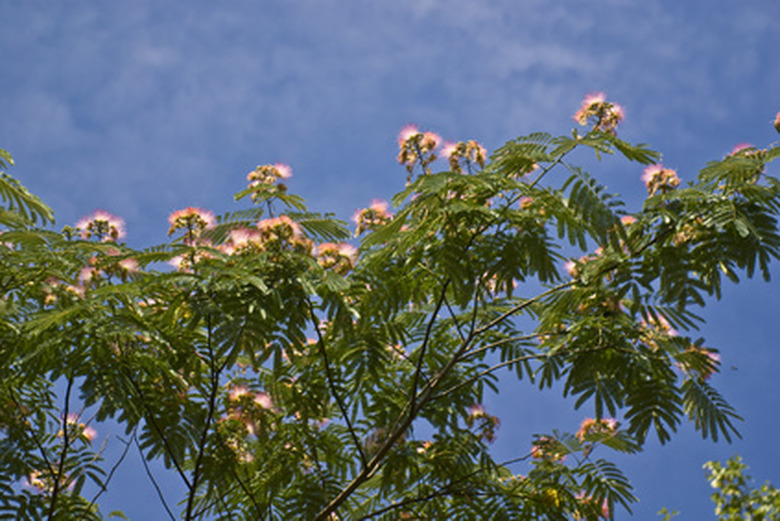The Toxicity Of A Silk Tree Seed Pod
The mimosa or silk tree (Albizia julibrissin) grows to a height of 40 feet. The green fern-like foliage measures up to 20 inches in length and 4 inches in width. During the summer months the tree produces pink and white powder-puff-style flowers. The blossoms' stamens often measure up to 1 inch in length. After flowering, the tree produces a flat seedpod that measures 6 inches in length and contains tiny 1/2-inch-long seeds. The seeds are toxic if consumed.
Seed Toxicity
Seedpods appear and begin to ripen on the silk tree from August to September. The seeds contain a neurotoxin known as ginkgotoxin, according to Daily Puppy. The seeds pose a significant danger to pets, children, horses and livestock if consumed.
- The mimosa or silk tree (Albizia julibrissin) grows to a height of 40 feet.
- After flowering, the tree produces a flat seedpod that measures 6 inches in length and contains tiny 1/2-inch-long seeds.
Symptoms
Ingestion of the silk tree seeds can produce gastric intestinal upset, stomach pain, lethargy, coma and seizures. The seeds may be deadly if prompt medical treatment is not sought after consumption, according to the Austin City Connection.
Seed Production
The seeds of the silk tree can remain viable for more than five years. Seeds have been successfully germinated which were stored in the open for 50 years, according to the National Park Service. The tree normally drops its seeds at its base and seedlings quickly develop but the seeds may be carried a great distance in the water.
Invasive
The silk tree can be extremely invasive when it escapes cultivation. The tree grows best in full sunlight and can quickly establish itself along roadways or in open areas. It grows well along streams, rivers, waterways and lake shores. The seeds can easily withstand water and will often be transported great distances in the streams or rivers.
- Ingestion of the silk tree seeds can produce gastric intestinal upset, stomach pain, lethargy, coma and seizures.
- The silk tree can be extremely invasive when it escapes cultivation.
Control
Cut the trees prior to seed production to reduce seed spread. When the silk tree is cut down it will quickly re-sprout from its root system or base. Pulling the seedlings and discarding them helps aid in control. Systemic herbicides also will effectively kill a silk tree.
